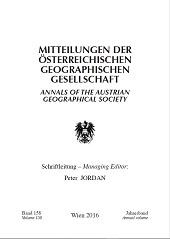
Mitteilungen der Österreichischen Geographischen Gesellschaft Band 158/2016, pp. 167-192, 2019/05/27
158. Jg. (Jahresband), Wien 2016

The objective of this paper is to identify the determinants of regional human capital endowments within Austria for the observation period 1971–2011. The two key questions are (i) whether, as observed in other countries, the spatial concentration of human capital increases over time and (ii) to what extent the knowledge intensity of current production affects current and future human capital endowments. The present paper combines an explorative with an explanatory study, where the latter consists of cross-sectional and panel regressions. The dependent variable equals average schooling years of the employed persons in a region, the observation area consists of Austria’s 99 districts. The estimations show that human capital endowments have converged across regions until 1991 and diverged again since then. Furthermore, the regression results display a negative impact of low and medium-low, but almost no impact of high and medium-high technology manufacturing industries on human capital growth. In contrast, the impact of knowledge-intensive services is positive.
Keywords: human capital, knowledge intensity, spatial inequality, Austria